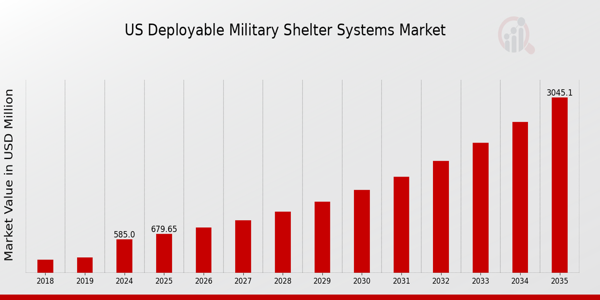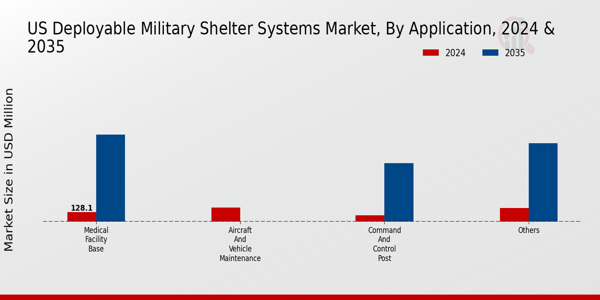US Deployable Military Shelter Systems Market Research Report: By Application (Command and control post, Medical facility base, Aircraft and vehicle maintenance, Others), By Product Type (Small Shelter system, Large Shelter system) and By Shelter Type (Hard wall shelter, Soft wall shelter) - Forecast to 2035.
US Deployable Military Shelter Systems Market Overview:
As per MRFR analysis, the US Deployable Military Shelter Systems Market Size was estimated at 463.74 (USD Million) in 2023. The US Deployable Military Shelter Systems Market Industry is expected to grow from 585(USD Million) in 2024 to 3,045 (USD Million) by 2035. The US Deployable Military Shelter Systems Market CAGR (growth rate) is expected to be around 16.18% during the forecast period (2025 - 2035).
Key US Deployable Military Shelter Systems Market Trends Highlighted
The US Deployable Military Shelter Systems market is experiencing significant advancements driven by various factors. Key market drivers include the increasing demand for rapid deployment capabilities by the military, who require flexible and functional shelter solutions for troops in diverse conditions. This emphasis on operational readiness is spurred by the need to maintain national security and respond effectively to both domestic emergency situations and global conflicts. Additionally, the growing focus on troop welfare and environmental sustainability is pushing the development of shelters that offer enhanced comfort and reduce the carbon footprint.Opportunities to be explored lie in the integration of smart technologies in deployable shelters, such as energy-efficient systems and modular designs. This will not only improve the living conditions for military personnel but also facilitate a quicker setup and breakdown of the shelters in the field. The US armed forces are keen on leveraging innovations that enhance situational awareness and reduce logistics burdens, which can be a targeted area for manufacturers and suppliers in this market. Recent trends in the US highlight an increased investment in research and development around deployable military systems to ensure the latest emerging technologies are incorporated into designs.Additionally, collaboration between government agencies and private sectors is fostering a more robust supply chain for these systems, underscoring a commitment to supporting military operations with adaptable shelter solutions. Overall, the growing emphasis on modern warfare needs and the shifting landscape of military operations in the US are shaping the deployable military shelter systems market.

Source: Primary Research, Secondary Research, MRFR Database and Analyst Review
US Deployable Military Shelter Systems Market Drivers
Increasing Defense Budgets in the US
The increasing defense budgets in the United States significantly drive the US Deployable Military Shelter Systems Market Industry. According to the Fiscal Year 2022 budget, the United States allocated over 700 billion USD for defense spending, which is projected to increase in subsequent budgets. This continual increase reflects a commitment to modernization and readiness within the military, thereby enhancing the need for advanced shelter systems.Specific plans from the Department of Defense emphasize modernization as a crucial factor, with investments aimed at deploying more flexible and efficient military infrastructure. Additionally, this trend has been endorsed by the Association of the United States Army, which advocates for advanced materials and technologies to maintain military operations. As defense budgets rise, the demand for innovative deployable military shelter systems is set to increase due to the corresponding need for enhanced operational capabilities in various environments, thereby providing a substantial growth opportunity for the market.
Growing Need for Rapid Deployment Capability
The rising global geopolitical tensions necessitate a growing need for rapid deployment capabilities for military forces across the United States. Under the guidance of the National Defense Strategy, the Pentagon emphasizes the importance of fast mobilization to address threats quickly and effectively. This situation compels the military to invest in deployable shelter systems that can be rapidly integrated into various operational settings, such as emergency response and securing base operations.A 2021 report by the Congressional Research Service indicated an increase in U.S. military readiness exercises by 15% over the past few years, highlighting the urgency and need for lightweight, versatile shelter solutions. As operational demands grow, the US Deployable Military Shelter Systems Market Industry is expected to thrive.
Collaboration with Defense Contractors
Strategic partnerships and collaborations with leading defense contractors significantly influence the growth of the US Deployable Military Shelter Systems Market Industry. Companies like Lockheed Martin and Northrop Grumman have a history of developing advanced deployable shelter systems that meet military specifications. These organizations continually invest in Research and Development to create innovative shelter designs capable of withstanding varied environmental conditions.According to the Defense Acquisition University, there was a recorded increase in collaboration contracts by 12% from 2019 to 2022, showcasing the military's initiative to enhance capabilities through private sector partnerships. This creates opportunities to diversify solutions in terms of materials, technologies, and efficiency, further propelling market growth.
Technological Advancements and Innovations
Technological advancements play a pivotal role in driving the US Deployable Military Shelter Systems Market Industry. Continuous Research and Development in materials and manufacturing have led to the production of lightweight, durable, and modular shelter systems that meet the rigorous demands of military applications. The National Institute of Standards and Technology has acknowledged the growing importance of innovation in military logistics, estimating a potential reduction in deployment time by as much as 30% through the adoption of new technologies.The transition towards smart shelter systems equipped with climate controls and enhanced living conditions illustrates the shift towards modernized military infrastructure. As technology evolves, the demand for advanced deployable military shelters is likely to increase, sustaining market expansion.
US Deployable Military Shelter Systems Market Segment Insights:
Deployable Military Shelter Systems Market Application Insights
The US Deployable Military Shelter Systems Market centered on the Application segment is an essential area within the broader market, comprising various critical functionalities to support military operations. The Command and Control Post is a fundamental component of this segment, serving as the nerve center for strategic planning and operational management in the field. Its importance is underscored by the growing need for real-time communication and data analysis in military operations, which directly contributes to mission success. Additionally, the Medical Facility Base has gained prominence, particularly in the recent years where rapid deployment of healthcare services is crucial during military operations and humanitarian missions. This ensures the wellbeing of personnel and civilians alike, highlighting its vital role in maintaining operational readiness and support.Aircraft and Vehicle Maintenance is another significant area, as the need to keep military assets operational is paramount for mission effectiveness. These specialized shelters provide a controlled environment for maintenance and repairs, reducing equipment downtime and ensuring that essential resources are available when needed. Lastly, the "Others" category includes various auxiliary applications that support diverse military functions, showcasing the versatility of deployable shelter systems. Factors such as advancements in materials and construction technology, alongside increasing defense budgets in response to geopolitical tensions, are driving growth within this segment. The distinct requirements of each application demonstrate the multidimensional nature of the US Deployable Military Shelter Systems Market and highlight opportunities for innovation and enhancement in design and functionality across all areas. Overall, this segment reflects a critical investment in ensuring that U.S. military operations can adapt and thrive in diverse environments.

Source: Primary Research, Secondary Research, MRFR Database and Analyst Review
Deployable Military Shelter Systems Market Product Type Insights
The US Deployable Military Shelter Systems Market exhibits a diverse range of Product Types, notably encompassing Small Shelter Systems and Large Shelter Systems. Small Shelter Systems are designed for rapid deployment and are crucial for tactical operations, often used in forward areas where space is limited and quick shelter solutions are essential. These systems offer mobility and ease of setup, catering to smaller units or personnel requiring immediate refuge. Conversely, Large Shelter Systems typically provide greater capacity and are employed in more extensive operations or base camps, offering ample amenities for personnel and equipment.These systems are particularly significant for logistical support in various missions, including humanitarian aid and disaster response. The growing need for versatile and resilient shelter solutions in the US military further emphasizes the importance of both Product Types. As the landscape of warfare and emergency response evolves, integrating innovative designs and materials will aid in enhancing operational efficiency, making the segmentation of the Deployable Military Shelter Systems Market vital for meeting both current and future military requirements.
Deployable Military Shelter Systems Market Shelter Type Insights
The US Deployable Military Shelter Systems Market features a differentiated segmentation focused on Shelter Type, primarily categorized into hard wall shelters and soft wall shelters. Hard wall shelters are gaining traction among military personnel due to their enhanced durability, security, and climate control features, which are essential for long-term deployments in diverse environments. Conversely, soft wall shelters are favored for their lightweight and portable design, making them ideal for rapid deployment and versatility in various operational scenarios.Each type serves distinct purposes; hard wall shelters tend to dominate in fixed installations requiring longevity, while soft wall options provide flexibility and quick set-up capabilities for evolving operational needs. The growth of these shelter types is driven by increasing defense budgets in the US, reflecting a commitment to modernization and readiness. Additionally, advancements in materials and construction technology are enhancing the performance and functionality of these shelters, presenting opportunities for innovation within the market.The relevance of these shelter types is crucial, given the US military's demanding logistical requirements and the need for reliable and efficient living and working spaces in the field.
US Deployable Military Shelter Systems Market Key Players and Competitive Insights:
The US Deployable Military Shelter Systems Market is currently a focal point of strategic development within military logistics and operational capabilities. As the need for rapid deployment and versatile sheltering solutions grows, various companies are vying for market share by innovating and enhancing the functionality of their offerings. Competitive insights in this market reveal that numerous manufacturers are investing heavily in research and development to produce lightweight, portable, and resilient shelter systems that can withstand diverse environmental conditions. The competitive landscape is characterized by a mix of established players and emerging firms, each aiming to provide advanced technology solutions that meet the evolving demands of military operations. The emphasis is not only on the design and durability of the shelters but also on their ease of assembly, transportability, and integration with other military systems.HDT Global stands out in the US Deployable Military Shelter Systems Market due to its strong commitment to providing specialized solutions suited for various military environments. The company has built a reputation for high-quality products that are designed with an emphasis on user adaptability and efficiency. HDT Global's strength lies in its extensive experience and expertise in delivering field-proven shelter systems that offer comfort and protection to military personnel in extreme conditions. Setting itself apart from competitors, the company leverages innovative technology and materials to enhance the survivability and functionality of its shelters, thereby ensuring operational readiness for a range of missions. The strong market presence of HDT Global is bolstered by its collaboration with key defense agencies and military branches, enabling it to maintain a significant footprint within the sector.Lockheed Martin also plays a significant role within the US Deployable Military Shelter Systems Market, recognized for its robust portfolio of solutions that extend beyond traditional shelter systems. The company offers a variety of shelters and associated support systems designed for tactical and operational environments, aimed at providing military bases and personnel with essential functionality. Lockheed Martin distinguishes itself through the integration of advanced technologies, which bolster communication and operational efficiency within deployed environments. The company is well-positioned in the market, bolstered by its reputation for reliability and innovation. Lockheed Martin has engaged in several strategic mergers and acquisitions that have expanded its capabilities and market reach in the military shelter segment. This approach has allowed the company to enhance its product offerings, diversify its technological assets, and strengthen partnerships with defense contractors and government entities in the United States. Its comprehensive array of products and services, alongside strategic growth initiatives, solidifies Lockheed Martin’s standing as a leader in the deployable military shelter systems market.
Key Companies in the US Deployable Military Shelter Systems Market Include:
HDT Global
Lockheed Martin
General Dynamics
SAIC
Marchetti Group
Gichner Shelter Systems
Rugged Portable Solutions
BAE Systems
Textron
L3Harris Technologies
AAR Corp
Oshkosh Corporation
Aimtek
Northrop Grumman
Rheinmetall
US Deployable Military Shelter Systems Market Industry Developments
The US Deployable Military Shelter Systems Market has recently seen significant developments, particularly with the ongoing focus on enhancing military readiness and response capabilities. Companies like Lockheed Martin and Northrop Grumman are innovating in lightweight, portable shelter solutions to provide better protections for troops in diverse environments. In terms of mergers and acquisitions, in September 2023, HDT Global announced its acquisition of Rugged Portable Solutions to augment its capabilities in providing advanced tactical shelters. This move reflects a broader trend of consolidation among key players, as they seek to enhance their portfolios amid increasing defense budgets driven by geopolitical tensions. In addition, the market has been bolstered by governmental initiatives aimed at upgrading military infrastructure, presenting opportunities for companies like General Dynamics and BAE Systems to secure significant contracts for new technologies. Over the last two years, notable projects have included the collaboration between SAIC and the US military for next-generation deployable command post solutions, emphasizing the importance of agile designs to meet evolving operational demands. The market dynamics are further influenced by growing investments in Research and Development aimed at integrating advanced materials and smart technologies into military shelter systems.
US Deployable Military Shelter Systems Market Segmentation Insights
Deployable Military Shelter Systems Market Application Outlook
Command and control post
Medical facility base
Aircraft and vehicle maintenance
Others
Deployable Military Shelter Systems Market Product Type Outlook
Small Shelter system
Large Shelter system
Deployable Military Shelter Systems Market Shelter Type Outlook
Hard wall shelter
Soft wall shelter
Report Scope:
| Report Attribute/Metric Source: |
Details |
| MARKET SIZE 2018 |
463.74(USD Million) |
| MARKET SIZE 2024 |
585.0(USD Million) |
| MARKET SIZE 2035 |
3045.0(USD Million) |
| COMPOUND ANNUAL GROWTH RATE (CAGR) |
16.18% (2025 - 2035) |
| REPORT COVERAGE |
Revenue Forecast, Competitive Landscape, Growth Factors, and Trends |
| BASE YEAR |
2024 |
| MARKET FORECAST PERIOD |
2025 - 2035 |
| HISTORICAL DATA |
2019 - 2024 |
| MARKET FORECAST UNITS |
USD Million |
| KEY COMPANIES PROFILED |
HDT Global, Lockheed Martin, General Dynamics, SAIC, Marchetti Group, Gichner Shelter Systems, Rugged Portable Solutions, BAE Systems, Textron, L3Harris Technologies, AAR Corp, Oshkosh Corporation, Aimtek, Northrop Grumman, Rheinmetall |
| SEGMENTS COVERED |
Application, Product Type, Shelter Type |
| KEY MARKET OPPORTUNITIES |
Increased defense budgets, Growing military readiness needs, Advancements in portable technology, Demand for rapid deployment solutions, Enhanced climate resilience requirements |
| KEY MARKET DYNAMICS |
increasing defense budgets, rapid technological advancements, growing deployment needs, enhanced mobility requirements, focus on sustainability and eco-friendliness |
| COUNTRIES COVERED |
US |
Frequently Asked Questions (FAQ) :
The US Deployable Military Shelter Systems Market is expected to be valued at 585.0 million USD in 2024.
By 2035, the market is projected to reach a valuation of 3045.0 million USD.
The market is anticipated to experience a compound annual growth rate (CAGR) of 16.18% during the forecast period from 2025 to 2035.
In 2024, the Aircraft and vehicle maintenance application segment is valued at 187.883 million USD, making it one of the larger segments.
The Medical facility base application segment is expected to reach a value of 1183.168 million USD by 2035.
Key players in the market include HDT Global, Lockheed Martin, General Dynamics, and BAE Systems, among others.
The Command and control post application segment is projected to be valued at 793.968 million USD in 2035.
The Others application segment is valued at 183.613 million USD in 2024.
There are significant growth opportunities driven by increasing military deployment needs and advancements in shelter technology.
Current global conflicts are likely to drive demand for deployable shelter solutions, enhancing market growth.
















